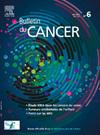Tumeurs de l’oreille : aspects chirurgicaux
IF 0.8
4区 医学
Q4 ONCOLOGY
引用次数: 0
Abstract
Contexte
L’oreille et la pyramide pétreuse s’étendent du pavillon externe jusqu’au centre de la boîte crânienne, avec des rapports vasculo-nerveux majeurs. Ils contiennent des structures essentielles impliquées dans l’audition, l’équilibre et la mobilité faciale. En raison de sa richesse histologique, l’oreille peut être le siège de tumeurs variées, allant des lésions bénignes aux cancers agressifs.
Matériel et méthodes
Cette revue narrative de la littérature propose un rappel de l’anatomie spécifique de l’oreille et de la partie pétreuse de l’os temporal suivi d’une description des différentes tumeurs bénignes et malignes pouvant s’y développer. Les principales techniques chirurgicales, les séquelles qu’elles engendrent ainsi que les moyens de réhabilitations disponibles sont également détaillés.
Principales données retenues
Les tumeurs bénignes de l’oreille sont dominées par les schwannomes vestibulaires, qui affectent le méat acoustique interne et l’angle ponto-cérébelleux. Les tumeurs malignes varient en fréquence, du très fréquent carcinome épidermoïde cutané du pavillon aux tumeurs rares du labyrinthe. La complexité anatomique de l’oreille et de ses fonctions et la faible incidence de ces tumeurs rendent leur diagnostic et leur prise en charge difficiles. Toute décision thérapeutique doit être soigneusement évaluée en tenant compte des séquelles qu’elle peut engendrer. Selon la localisation de la lésion, les défis chirurgicaux varient, d’un impact esthétique à des complications fonctionnelles, voire à un risque vital.
Conclusion
Les conséquences de la chirurgie, ainsi que les options de réhabilitation, doivent faire l’objet d’un consensus en comité multidisciplinaire avant d’être discutées avec le patient afin d’optimiser sa prise en charge.
Background
The ear and the petrous pyramid extend from the external auricle to the center of the cranial cavity, featuring a complex anatomy and significant neurovascular relationships. The ear houses essential structures involved in hearing, balance, and facial mobility. Due to its rich histological composition, the ear can be affected by a wide range of tumors, from benign lesions to aggressive cancers.
Materials and methods
This narrative literature review provides an overview of the specific anatomy of the ear and the petrous portion of the temporal bone, followed by a description of the various benign and malignant tumors that may develop in this region. The main surgical techniques, the sequelae they may cause, and the available rehabilitation options are also detailed.
Key findings
Benign tumors of the ear are primarily represented by vestibular schwannomas, which affect the internal auditory canal and the cerebellopontine angle. Malignant tumors vary in frequency, ranging from the very common cutaneous squamous cell carcinoma of the auricle to rare tumors specific to the labyrinth. The complex anatomy of the ear, the essential functions of its structures, and the low incidence of these tumors make their diagnosis and management particularly challenging. Any therapeutic decision must be carefully evaluated, considering the potential sequelae it may cause. Depending on the location of the lesion — whether superficial or deep — surgical challenges range from aesthetic concerns to functional complications and even life-threatening risks.
Conclusion
The consequences of surgery, as well as available rehabilitation options, should be discussed within a multidisciplinary team before being presented to the patient to optimize management.
[耳部肿瘤:外科方面]。
背景:耳和石状锥体从外耳延伸到颅腔中心,具有复杂的解剖结构和重要的神经血管关系。耳朵容纳着与听力、平衡和面部活动有关的基本结构。由于其丰富的组织学组成,耳朵可以受到各种肿瘤的影响,从良性病变到侵袭性癌症。材料和方法:这篇叙述性文献综述概述了耳和颞骨岩部的具体解剖结构,随后描述了该区域可能发生的各种良性和恶性肿瘤。主要的手术技术,它们可能引起的后遗症,以及可用的康复方案也详细。主要发现:耳部良性肿瘤以前庭神经鞘瘤为主,主要影响内耳道和小脑桥脑角。恶性肿瘤的发生频率各不相同,从非常常见的耳廓皮肤鳞状细胞癌到罕见的迷宫肿瘤。耳部复杂的解剖结构,其结构的基本功能,以及这些肿瘤的低发病率使其诊断和治疗特别具有挑战性。任何治疗决定都必须仔细评估,考虑到它可能引起的潜在后遗症。根据病变的位置,无论是浅表还是深部,手术的挑战范围从美学问题到功能并发症甚至危及生命的风险。结论:手术的后果,以及现有的康复选择,应在多学科团队讨论,然后再提交给患者,以优化管理。
本文章由计算机程序翻译,如有差异,请以英文原文为准。
求助全文
约1分钟内获得全文
求助全文
来源期刊

Bulletin Du Cancer
医学-肿瘤学
CiteScore
1.90
自引率
16.70%
发文量
224
审稿时长
37 days
期刊介绍:
Without doubt, the ''Bulletin du Cancer'' is the French language publication of reference in the field of cancerology. Official organ of the French Society of Cancer, this journal covers all the information available, whether in the form of original articles or review articles, but also clinical cases and letters to the editor, including various disciplines as onco-hematology, solids tumors, medical oncology, pharmacology, epidemiology, biology as well as fundamental research in cancerology. The journal proposes a clinical and therapeutic approach of high scientific standard and regular updates in knowledge are thus made possible. Articles can be submitted in French or English.
 求助内容:
求助内容: 应助结果提醒方式:
应助结果提醒方式:


